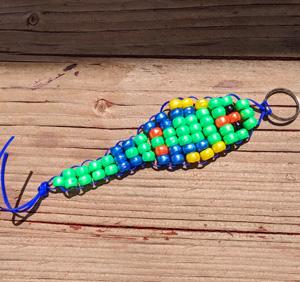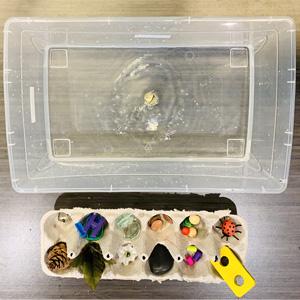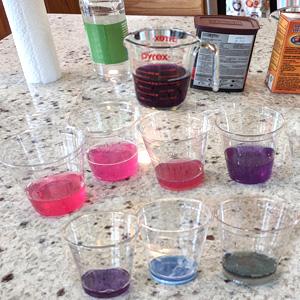Supplies:
- Pattern or picture of design
- 4ft of craft lace
- Key Ring
- Scissors
- Pony beads
- 35 green
- 15 blue
- 6 yellow
- 4 orange
- 2 black
Directions:
- Tie your craft lace to your key ring, leaving two legs of equal length.
- Look at the top line of your pattern, and find pony beads to match that line. If you’re using the bird pattern, the first line will be 3 green beads.
- String those beads onto one of the legs of craft lace, in the order you see them on the pattern. (This may not matter for the first line, but it’s important later on!) Push the beads up to the top of the craft lace, next to the key ring.
- Now, string the other leg of craft lace through beads in the opposite direction of the first leg. Pull the craft lace all the way through. Reposition the line of beads so that they form the bottom side of a craft lace triangle, with the keyring as the triangle’s top corner. When you’re done, you should have to two equal lengths of craft lace again, one on either side of the line of beads.
- Repeat steps 2-4 with every line of your pattern.
- When you’re done, tie a knot in the craft lace at the bottom of your design, and trim any excess length. Good job!
Watch this project at: https://youtu.be/T6w5u62hrp0?list=PLxg4vmuqrAtckvp9eurSGEI2DwSb1wI6o
Supplies:
- A container filled with water
- Various objects of different sizes and weights - examples: beads, rocks, pennies, small plastic toys
Directions:
- Drop in objects and observe the effect on the water
- Discuss what you see. Do you notice a ripple? Does it make a splash? What happens if you drop in lots of objects at once?
- Discuss how our behavior and actions also have an effect on the world around us.
- Make a list of acts of kindness you can do.
- Spread the ripple effect of kindness!
Watch this project at: https://www.youtube.com/watch?v=zHM_X3wcmfQ&list=PLMEg2Dd0dSFctLfDQxsL5…
Supplies:
- 2-3 purple cabbage leaves
- 4 cups water
- Blender
- Strainer
- Bowl
- Paper towel
- Several clear containers or cups
- Vinegar
- Baking soda
- Optional: liquid dishwasher detergent, fruit juice, clear soda or carbonated water, soap, salt, other kitchen substances (with grownup approval)
Directions:
- Tear 2 to 3 leaves off the head of a purple cabbage, tear leaves into smaller pieces.
- Put cabbage leaves into a blender with about 4 cups of water and with a grownup's help, blend on high until the liquid is very purple with a few chunks remaining.
- Strain cabbage juice into mesh strainer lined with paper towel, over a large bowl.
- Pour the cabbage juice into a container or pitcher. This purple cabbage juice is now your pH indicator.
Purple cabbage juice contains a compound called anthocyanin. Anthocyanin will turn pink when mixed with acid, blue-green when mixed with a base, and purple when mixed with a neutral substance, such as water. - Take 3-4 additional clear containers: add a spoonful of baking soda to one cup; add a few spoonfuls of vinegar to a second cup; add a bit of water to a third cup.
- Ask your grownup if you can use a small amount of dishwasher detergent into an additional cup.
- Now, you'll add some cabbage juice to each of the four cups you've prepared, even the one that's just water. When the purple cabbage juice is mixed with vinegar, what happens? (You should see the mixture turn pink.) Why? Vinegar is an acid. Pour cabbage juice into the container with baking soda, then also the cup with the dishwasher soap. What is happening to these two solutions? (Baking soda is a base, so it will turn bluish-purple. The dishwasher soap mixture should turn a vivid blue-green because dishwasher soap is very basic, or alkaline.) What happened when you added cabbage juice to just water?
- Line your four cups up on the counter. You will use these color results to compare other substances you want to test to see if they are acids or bases.
- Pink indicates an acid. Place this cup to the left. Purple (water) is neutral. Place this one in the middle. Blue-green is basic. Place this cup to the right of the purple cup. If you used dishwasher detergent, place this cup to the very far right. It’s one of the most alkaline substances you will find in a kitchen.
- Now, try adding purple cabbage juice to other substances you want to test.
- Compare the colors of your test mixtures and place them between the cups, where you think they should go. Soon, you will have a spectrum of acids and bases and you can compare the acidity of two substances, such as vinegar vs. orange juice.
Watch this project at: https://www.youtube.com/watch?v=7nB1UzYZf4s&list=PLMEg2Dd0dSFctLfDQxsL5…





